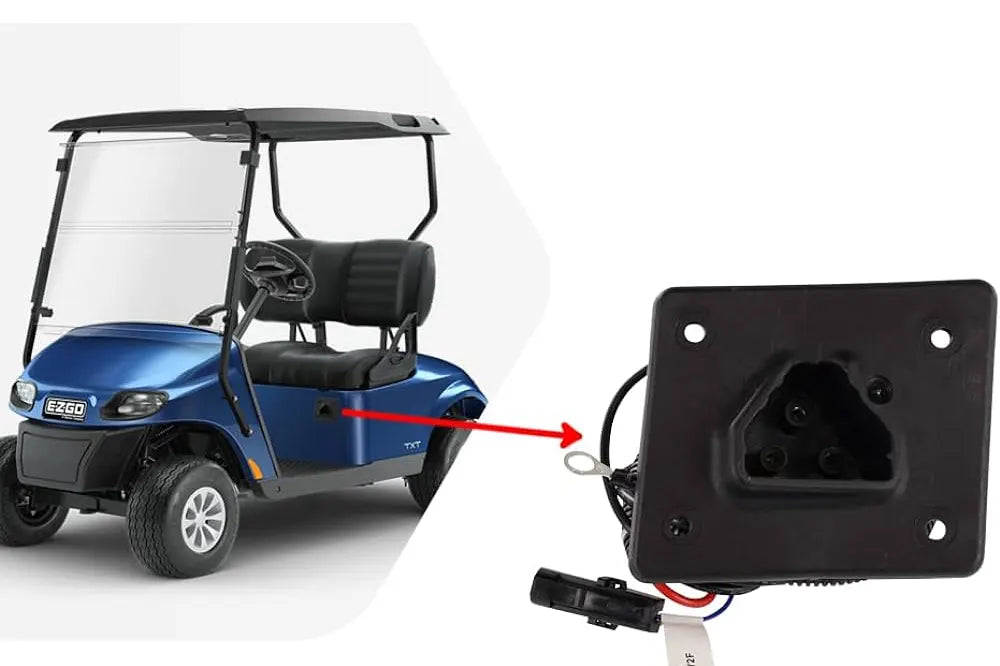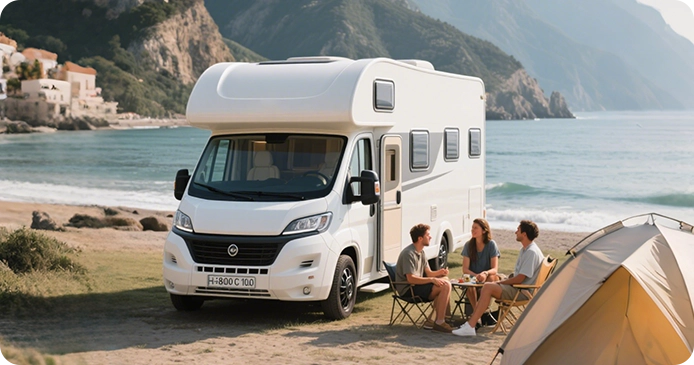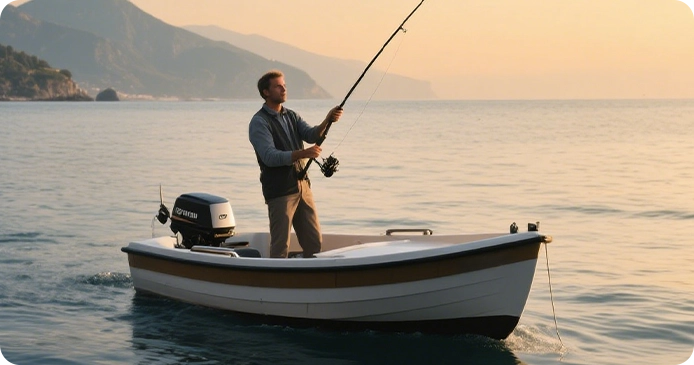Deep cycle batteries are the marathon runners of energy storage, delivering steady power over long periods for applications like RVs, boats, and solar systems.
Unlike regular car starting batteries, deep-cycle batteries are designed to provide a long, stable supply of power. They are a core component in renewable energy systems, RVs, marine vehicles, and off-grid applications.
With lithium-ion batteries gaining traction for their efficiency and longevity, this guide explores the deep cycle definition, construction, types, applications, maintenance, and tips to maximize service life, helping you choose the best deep cycle battery for off-grid needs.
What Is a Deep-Cycle Battery?
When we talk about batteries, most people probably think of the starting battery in your car that starts the engine, or the lithium-ion battery in your cell phone. However, a deep-cycle battery is a completely different type of energy storage battery.
As the name implies, a deep-cycle battery is an electrochemical energy storage device specifically designed to withstand multiple deep discharges (typically up to 80%-100% of its rated capacity) and to withstand frequent charge and discharge cycles.
This is in stark contrast to a car starting battery, which is designed only to deliver short bursts of high current (typically using only 3%-5% of its capacity) to start the engine, while a deep-cycle battery acts like a reliable fuel tank, providing long-lasting, steady power to devices like golf carts, marine electronics, or solar panels.
To identify a deep-cycle battery, look for the label, consult the device manual, or test its discharge rate (deep-cycle batteries deliver a steady, low current). Lithium-ion deep-cycle batteries can withstand up to 100% deep discharge without damage, while lead-acid deep-cycle batteries utilize thicker lead plates to withstand deep cycling, unlike starting batteries.
How Does a Deep Cycle Battery Power Your Devices?
All batteries essentially convert chemical energy into electrical energy, but deep-cycle batteries optimize this energy conversion process through a special design, making them more suitable for deep discharges and cycling. Think of it like a sturdy water tank that can be filled and drained repeatedly without wear.
During discharge, the battery releases its stored energy to power devices. In a lead-acid deep-cycle battery, imagine the negative lead plates (like the fuel source) reacting with the sulfuric acid electrolyte (the spark), producing lead sulfate and releasing electrons. Simultaneously, the positive lead dioxide plates also react, producing more lead sulfate and water. These electrons flow from the negative to the positive plates through an external circuit, generating an electric current that powers your RV lights or trolling motor.
Unlike regular car batteries, deep-cycle batteries have thicker, stronger plates filled with active material, enabling them to handle large amounts of lead sulfate accumulation during deep discharges without permanent damage, much like a durable backpack that can carry heavy loads without tearing. During charging, an external power source pumps energy back into the battery, reversing the chemical reactions like playing a movie in reverse. The lead sulfate on the positive plates converts back into lead dioxide, while the lead sulfate on the negative plates turns into spongy lead, and the sulfuric acid returns to the electrolyte. This process restores the battery's ability to deliver power.
Deep-cycle batteries, especially lithium-ion batteries, are like efficient cooks, converting charging energy into stored electricity more efficiently than standard lead-acid batteries. However, they require precise charging control, like following a recipe to the letter, to avoid overcharging, which can damage the battery's health.
What Are the Types of Deep Cycle Batteries for Your Needs?
Deep cycle batteries come in various forms, each suited to specific needs. When choosing a deep cycle battery type, you need to consider the purchase budget, usage environment, and performance requirements. The table below summarizes their key characteristics:
Type of Battery
Cost
Maintenance
Lifespan
Flooded Lead-Acid
Low
High (add distilled water, ventilation)
4-8 years
VRLA (AGM and Gel)
Moderate
Maintenance-free
4-8 years
Lithium LiFePO4
High
Maintenance-free
8-10 years
Flooded Lead-Acid Deep-Cycle Batteries
Flooded deep-cycle batteries, also known as wet cells, are the most traditional and economical battery type choice. They use a liquid electrolyte in which the plates are immersed, and typically require regular checking and adding distilled water to maintain the electrolyte level. Their advantages lie in low initial cost, mature technology, complete recycling system, and relatively low requirements for charging equipment.
However, flooded batteries must be mounted vertically, pose a risk of leakage, and can generate flammable hydrogen gas and corrosive acid fumes during charging, requiring installation in a well-ventilated area. These batteries are commonly used in golf carts, forklifts, and some off-grid solar systems, making them suitable for those on a budget who can handle basic maintenance.
Valve-Regulated Lead-Acid (VRLA) Deep-Cycle Batteries
This is an upgraded version of flooded lead-acid technology and includes both AGM (Absorbed Glass Mat) and Gel battery types.
AGM deep-cycle batteries use a fiberglass separator to absorb the electrolyte, making them a dry design. They offer advantages such as being maintenance-free, leak-proof, flexible side-mounting, low self-discharge, and fast charging.
Gel batteries, on the other hand, use the electrolyte in a gel-like state, offering greater shock resistance, longer cycle life, and improved deep-discharge recovery, but they are generally more expensive and more sensitive to charging voltage.
These VRLA batteries are particularly suitable for uses such as RVs, marine vehicles, and for those who do not want frequent maintenance.
Deep-Cycle Lithium Batteries
Lithium-ion batteries, particularly LiFePO4 batteries, have rapidly emerged as a leading battery option. Compared to traditional lead-acid batteries, they offer high energy density (smaller volume and lighter weight for the same capacity), long cycle life (up to 3,000-5,000 cycles), fast charging, high efficiency, and a depth of discharge of 80%-100% without affecting lifespan.
In addition, lithium batteries are maintenance-free, have extremely low self-discharge rates, and operate over a wider temperature range. While their initial cost is higher, their exceptionally long lifespan and superior performance often result in a lower total cost of ownership. Deep-cycle lithium batteries have become the preferred choice for high-end RVs, yachts, solar energy storage systems, and electric vehicles.
How Do Deep Cycle Batteries Power Your Adventures?
Due to its unique performance characteristics, deep-cycle batteries provide stable and reliable power support for various devices in various applications, from home energy storage to mobile transportation. Understanding these applications not only helps you understand the importance of deep-cycle batteries but also helps you choose the most suitable battery type for your specific needs.
The following are their main uses:
Recreational Vehicles (RVs) and Marine: Modern RVs are often equipped with independent household battery systems to power household appliances such as lighting, refrigerators, televisions, and water pumps. These systems almost exclusively utilize deep-cycle batteries. On marine vessels, deep-cycle batteries not only power critical electronic equipment like navigational equipment, communication radios, and fish finders, but may also start auxiliary engines. High-quality deep-cycle marine batteries typically feature special terminal seals and anti-corrosion coatings, along with lightweight designs with IP65 protection. These batteries are ideal for applications where space is limited. Vatrer's 12V and 24V deep-cycle lithium batteries, for example, are designed to provide long-lasting, stable power for electronic equipment in Class A, B, and C RVs and marine vessels.
Golf carts and electric mobility devices: Electric golf carts typically use 6V or 8V deep-cycle lead-acid batteries, with 6-8 batteries connected in series to form a 36V or 48V system. These batteries require daily deep discharge (perhaps 70%-80% after 20-30 kilometers of driving) and then full charge at night, resulting in a cycle life of 2-5 years. Similar electric mobility devices include airport ground handling vehicles, electric wheelchairs, and sweepers, all of which rely on batteries for 24/7 power. With the popularity of lithium batteries, many fleet managers and owners are upgrading from ordinary batteries to deep-cycle golf cart lithium batteries. A single charge can support multiple rounds of 18-36 holes of competition. The long service life and maintenance-free design greatly reduce the trouble of electric vehicle downtime and frequent replacement.
Renewable energy systems: In solar or wind power generation systems, deep-cycle battery packs serve as the core of energy storage, responsible for storing excess electricity generated by photovoltaic panels during the day for use at night or when there is no wind. Such applications typically require batteries that can withstand frequent charge and discharge cycles, have a high depth of discharge, and good overcharge tolerance. Off-grid solar systems are particularly dependent on the performance of deep-cycle batteries, and battery packs often need to work continuously for days or even weeks without damage. If you are looking for solar energy storage batteries, the Vatrer 51.2V 100Ah rack-mounted battery and 51.2V 200Ah wall-mounted energy storage battery are all-in-one battery packs designed for off-grid home storage applications. Compared to ordinary batteries, they have a longer service life and provide a power output of 5,120-10,240W. They can also be expanded according to your needs and support Bluetooth connection to mobile phones for real-time monitoring of battery status.
How to Choose the Best Deep Cycle Battery for Your Needs?
Selecting the right deep cycle battery involves balancing capacity, lifespan, and application needs. Ask yourself: What's my budget? How much power do I need? Will the battery face harsh conditions?
Consider these factors:
Capacity: This is the primary parameter to consider when selecting a deep-cycle battery. It's typically expressed in ampere-hours (Ah), indicating the amount of current the battery can deliver over a specific period of time. For example, a 100Ah battery can theoretically discharge continuously at 5A for 20 hours (20-hour rate capacity). However, when selecting a battery, it's important to understand that battery capacity is affected by discharge rate. The actual usable capacity of the same battery decreases at high discharge rates, a phenomenon particularly pronounced with lead-acid batteries. Calculating your system's total power requirements (ideally adding a 20%-30% safety margin) is the basis for determining the required battery capacity. Underestimating this requirement will lead to premature battery depletion, while over-sizing will result in unnecessary weight and cost.
System Voltage Compatibility: Traditional deep-cycle batteries are available in common voltage levels, such as 2V, 6V, and 12V. These batteries can be connected in series to achieve the required system voltage. For example, off-grid solar systems often utilize 24V or 48V architectures, which can be achieved by connecting two or four 12V batteries in series or using a single 24V or 48V lithium-ion battery pack. When selecting a battery voltage, consider the existing system architecture and inverter input requirements. It's important to note that when connecting batteries in series, choose batteries of the same model, batch, and even those with closely matched initial performance to avoid single-cell variations that could limit the performance of the entire battery.
Physical size and weight: This is an often overlooked but crucial factor. Deep-cycle batteries, especially lead-acid types, are often quite bulky. A single 12V100Ah AGM battery can weigh up to 30 kg. When selecting a battery, consider the size limitations and load capacity of the installation space, as well as the availability of accessible transport paths. Lithium-ion batteries offer significant advantages in weight and size. For the same capacity, they weigh only one-third of lead-acid batteries, making them particularly important for weight-sensitive applications such as RVs and marine vehicles.
Temperature compatibility: This is also a crucial factor to consider when purchasing a battery. The performance of all batteries is affected by ambient temperature, but to varying degrees. Lead-acid batteries experience a significant capacity drop at low temperatures; at -4°F/-20°C, they may only have 50%-60% of their normal capacity. Lithium-ion batteries, on the other hand, offer better low-temperature performance. If you're installing your battery in a non-temperature-controlled area, such as under an RV chassis or in a boat's engine compartment, pay special attention to the operating temperature range listed in the product's specifications and prioritize models suitable for your climate. For example, Vatrer offers deep-cycle batteries with self-heating features. In extreme temperatures, batteries require an insulated box or temperature control system, which is crucial for extending battery life.
Initial Budget and Long-Term Cost: Budgetary cost is often the primary factor in the final battery purchase decision. While the initial purchase price is important, deep-cycle lithium batteries are the best long-term investment. Their total cost of ownership includes initial cost, cycle life, maintenance, and ultimate payback value. For example, a high-quality 100Ah deep-cycle lithium battery from Vatrer may initially cost three times as much as a comparable lead-acid battery, but its cycle life is five times longer and it requires virtually no maintenance, making it more economical in the long run.
How Long Does a Deep Cycle Battery Last in Real-World Use?
The service life of a deep cycle battery depends on its type, usage, and maintenance. Lead-acid deep cycle batteries typically last 4-8 years or 300-500 cycles at 50-80% DoD. Lithium LiFePO4 batteries can last 8-10 years or 3,000-5,000 cycles, even with daily cycling, such as powering a solar cabin daily.
Factors affecting lifespan include:
DoD: Deeper discharges shorten lead-acid battery life but have less impact on lithium.
Charging Habits: Consistent overcharging or undercharging reduces capacity.
Temperature: Extreme heat or cold accelerates degradation, though lithium batteries perform better in varied conditions.
To illustrate capacity, the table below shows how a 100Ah battery powers different devices:
Device
Power Draw (Amps)
Runtime (Hours) at 50% DoD
Runtime (Hours) at 100% DoD
RV Fridge
2
25
50 (lithium only)
LED Lights
0.5
100
200 (lithium only)
Trolling Motor
10
5
10 (lithium only)
How Should You Charge a Deep Cycle Battery?
Use a smart charger designed for your type of battery to avoid overcharging or undercharging. Flooded deep cycle batteries typically take 8-12 hours to charge, depending on capacity and charger amperage, while lithium-ion batteries charge faster, often in 3-6 hours, with BMS ensuring safe charging.
Avoid using a car alternator, as it may not fully charge a deep cycle battery and can reduce its service life.
For long-term storage, use a trickle or float charger to maintain charge, especially for lead-acid deep cycle batteries, which lose 10-35% charge monthly compared to lithium's 2-3%.
How to Manage Battery DoD for Longevity?
The depth of discharge (DoD) impacts battery health. For lead-acid deep cycle batteries, aim to discharge between 50-80%, such as using 50Ah of a 100Ah battery to maximize lifespan, as deeper discharges accelerate wear. Lithium-ion batteries can safely discharge to nearly 100% without significant damage, making them ideal for demanding applications like daily RV and electric golf cart use.
How to Maintain Deep Cycle Batteries on a Daily Basis?
For flooded deep cycle batteries, check electrolyte levels monthly, top up with distilled water, and ensure ventilation to prevent gas buildup. Recycle these batteries properly to minimize environmental impact.
AGM and Gel batteries are maintenance-free, but clean terminals regularly to avoid corrosion.
Lithium-ion batteries require minimal upkeep, thanks to their sealed design and BMS. Store all batteries in a cool, dry place, avoiding extreme temperatures to maintain efficiency.
Why Choose Vatrer Battery for Your Deep Cycle Needs?
For reliable and efficient deep cycle batteries, Vatrer Battery offers advanced lithium batteries designed for modern energy demands. Models like the 12V 100Ah battery provide a lifespan of up to 5,000 cycles and weigh 40% less than lead-acid, ideal for RVs, boats, golf carts and solar systems. Their maintenance-free operation and built-in BMS prevent overcharging and overheating, while Bluetooth monitoring (available on select models) lets you track battery health via a mobile app.
Conclusion
Deep cycle batteries are essential for powering applications that demand steady energy over long periods of time, from golf carts to renewable energy systems. By understanding their types flooded lead-acid, AGM, Gel, and lithium-ion batteries, and following proper maintenance practices, you can ensure reliable performance and a long service life. With lithium-ion batteries driving the future of sustainable energy, choosing the right deep cycle battery empowers you to stay powered anywhere.


































































































